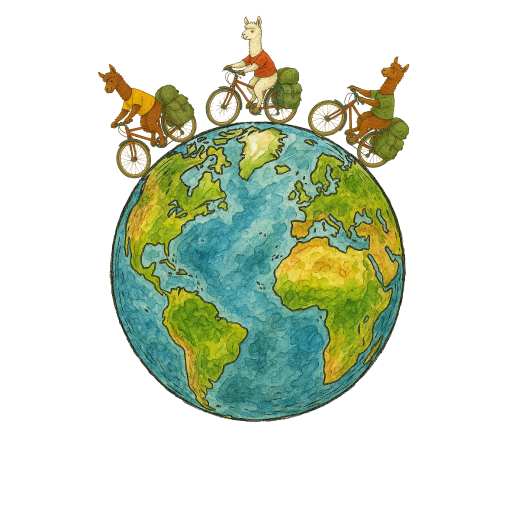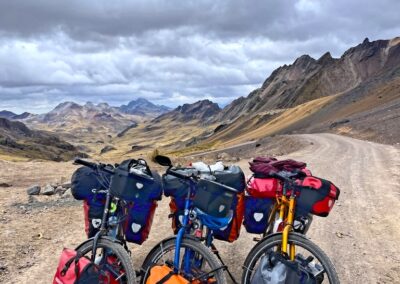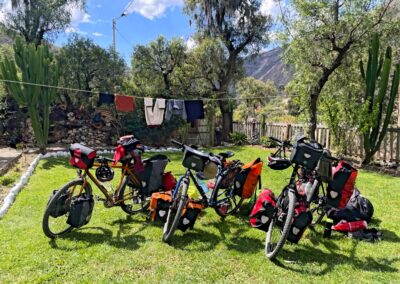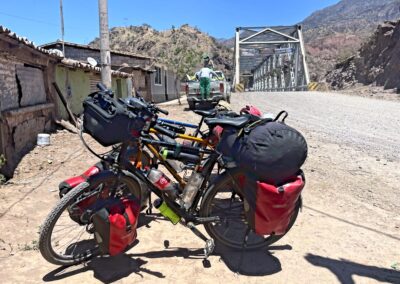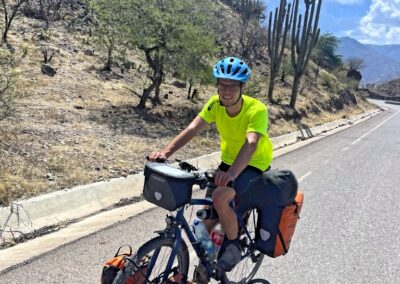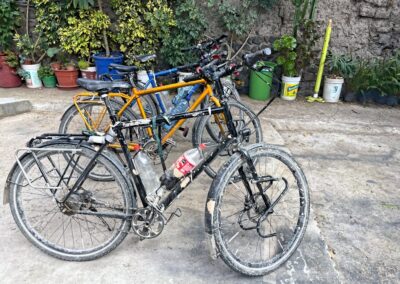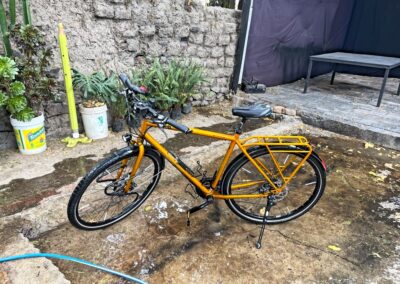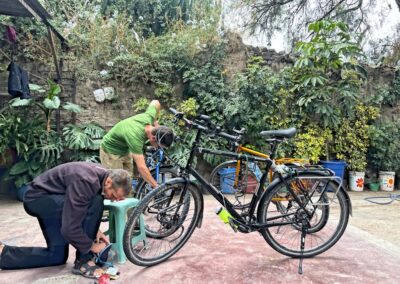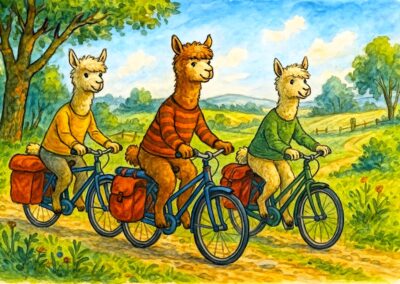A Post For Our Fellow Bike-Lovers
Disclaimer:
This post will detail what types of bikes we have with what features in quite some detail. Therefore, it might bore non-bike enthusiasts, which is why they are recommended to not read any further beyond this point.
As the disclaimer points out, this section is dedicated to our trusty bikes which have been carrying us through South America and had to endure all the weather and road conditions that we do. All of us got our bikes from our trusted dealer of choice for high-quality touring bikes: Radscheune in Erfurt. Shoutout to you guys for supporting us in choosing the right bike, sharing advice through experiences from other bikepackers, and being as excited for your bikes going on this amazing trip as we were. At this point, I’d also particularly like to thank Ralf for accompanying both me and my dad individually all the way to Erfurt (together with Göran :)). Choosing the right bicycle is difficult, but Ralf supported us with his experience-based advice, empathy, and a great deal of patience. I’d like to thank both Ralf and Carmen as well for going through the trouble of picking up my bicycle for me when I already lived in the Netherlands. Thank you so much! 🙂
Jacques’ Bike
There is no other way to say this than right out as it is: Jacques has the best and most sophisticated bicycle amongst the three of us (I guess working at VW gives you a slightly larger budget than a student :P).
Frame brand: ToutTerrain
Frame material: steel
Dynamo brand: Son 28
Brake type: hydraulic disc brakes
Brake brand: Magura
Gear: Rohloff 14-speed hub gear
Tires: 28-inch Schwalbe Mondial
What sets ToutTerrain frames apart is not only the attention to fine quality in detail but most importantly the sturdy steel frame with a welded rear luggage carrier. This design gives maximum stability, particularly for heavy loads — an important feature when you’re carrying everything you need for three months on the road with mediocre road conditions.
The bike is fitted with a high-end steering bearing set from King’s Cross, one of the best in its class. So far, it has performed flawlessly. Just below the headset, a small stopper is included in the frame which prevents the front wheel from angling too much in parked position. Fellow bikers will know just how annoying it is when the front wheel starts moving, rotating it around the rear tire, which usually ends in it falling over. In addition to the King’s Cross headset, the handlebar is equipped with leather handles, which add a nice touch of comfort, especially on long rides or bumpy roads.
The Son dynamo reliably powers the bright and good LED lighting when needed. Dynamos are a great thing: you don’t have to worry about batteries since you always have a power source (which is good enough to power the LEDs when light is needed). A small charger is even built into the steering column, allowing phones to be charged directly from the dynamo. That said, it has its limitations. It only works efficiently above 15 km/h, which means it’s almost useless on steep climbs or rough roads — exactly the places where charging would be most helpful. On top of that, the charging speed is painfully slow.
For braking, Jacques relies on Magura hydraulic disc brakes. They provide excellent stopping power, which is crucial when you’re slowing down a fully packed 50 kg bike plus a 75 kg rider barreling down a mountain road.
What surprises many people we have met in Peru so far is that all three of us don’t have suspension in the front fork. This may sound like a disadvantage, but in dusty environments suspension would only collect dirt and wear out quickly. Plus, skipping suspension keeps the weight down — which is always a win on a touring bike.
Hydration is covered with four bottle holders: two standard-sized and two that fit 1.5-liter bottles. This setup has proven extremely practical, especially in remote areas where water is scarce.
The heart of the bike is the Rohloff 14-speed hub gear. It’s smooth, efficient, and avoids the annoying overlap that traditional derailleur systems often have. In the mountains, it really shines. The lightest gear moves the bike only 1.28 meters per pedal rotation, which is so small that it’s rarely needed, but an absolute lifesaver on brutal climbs. Any lighter gear would actually make it hard to maintain balance or to start pedaling uphill from a standstill. In practice, the second and third gears are used the most when climbing.
The bike rolls on 28-inch Schwalbe Mondial tires with an aggressive tread. Reinforced with steel wires, they’re built for durability and puncture resistance. So far, they’ve held up perfectly.
At the front, the luggage is carried on a Tubus low rider rack. Apart from a few assembly issues at Lima airport, it has proven to be stable and reliable.
All in all, Jacques’ bike is a true workhorse. It’s built for endurance, reliability, and comfort — everything you could wish for on a long-distance cycling journey. While not every component is perfect (looking at you, dynamo charger), the overall package is something he is very grateful to have on this adventure, and it is a bicycle he is very fond of.
Elke’s Bike
I guess in terms of components my bike could be described as the second-best, but all three of our bikes are good — and mine is only better than Göran’s because I exceeded my original budget by quite a bit. Why? I saw this bike and it was love at first sight. It ruined all other options for me.
Frame brand: ToutTerrain
Frame material: steel (but heavier than the ToutTerrain frames)
Dynamo brand: Son 28
Brake type: hydraulic ceramic disc brakes
Brake brand: Shimano
Gear: Shimano Deore XT, Bowden cable operated
Tires: 28-inch Schwalbe Mondial
My bike is also a ToutTerrain, built on the same solid steel frame as Jacques’, but where his is a modest black (which makes it look less expensive to the untrained eye), mine screams for attention with its matte metallic orange finish. It is for that reason that I have lovingly dubbed my bike Naranja.
Other commonalities are:
-
the King’s Cross headset and steerer tube assembly
-
stopper for the front tire
-
Tubus lowriders
-
Cinq integrated dynamo-powered charger
Because my phone has a smaller battery though, charging works a bit better for me (unless we go uphill, of course). To be clear: the dynamo-powered charger is the second-best available method to charge your phone using the dynamo. The only better but less known, more expensive, and slightly more complex option is using a Forumslader charger.
It also differs in a few key components though. For instance, for braking, my bike is equipped with hydraulic Shimano disc brakes, and I remember there was something special about them which slightly set them apart from Göran’s, but I’m ashamed to admit that I have forgotten what that fancy difference was. So far, they have provided excellent stopping power even on long, steep downhill stretches.
The gearing system is also quite different. Instead of the Rohloff hub, I use a traditional derailleur setup with three chainrings in the front and ten sprockets in the back. Given the total weight of bike, luggage, and me (combined with the steep Andean terrain), I rely heavily on the two smaller chainrings up front. In the back, I mostly use the middle gears for rolling terrain and the larger ones when grinding uphill. In the lightest gear, a full pedal rotation moves me about 1.5 meters forward. It’s manageable most of the time, but on particularly steep climbs it can feel a little heavy compared to Jacques’ lower Rohloff gearing. That’s when I push my bike and the men don’t.
Overall, my ToutTerrain is a reliable and sturdy touring bike which I have loved ever since the moment I bought it. Nay, since I first saw it. But riding on it in this terrain, I appreciate its quality and reliability even more than I did when cycling with it in the Netherlands. All in all, it feels like a trustworthy steel horse for this journey.
Göran’s Bicycle
Göran also has a great bike — there’s no mistaking that. It’s merely a bit more economical than Jacques’ and mine.
Frame brand: Intec
Frame material: steel
Dynamo brand: Son 28
Brake type: hydraulic disc brakes
Brake brand: Shimano
Gear: Shimano Deore XT, Bowden cable operated
Tires: 28-inch Schwalbe Mondial
Göran rides an Intec touring bike, built around a classic welded steel frame, which is slightly heavier than my ToutTerrain of the same frame size. Unlike the ToutTerrain bikes, which have the luggage carrier welded directly into the frame, his rear rack is a separate bolted-on system. This means it’s not quite as resilient as the integrated design, but it still does its job well. And most importantly: Göran is happy with it.
The bike’s more traditional construction makes it familiar and easy to maintain, while still offering the strength and durability needed for long-distance touring. Though the rear rack may not reach the same level of stability as the ToutTerrains, it has held up reliably under the demands of fully loaded travel.
A useful extra feature on Göran’s setup is the Forumslader charger, connected to the front dynamo. It allows him to effectively and reliably charge devices while riding, which is especially practical for long stretches without access to electricity. Compared to the stem-integrated chargers on the ToutTerrains, the Forumslader is known for its efficiency and reliability, even at lower speeds.
All other components such as the headset and luggage carrier are not mentioned because they are not as special as on Jacques’ and my bike and therefore not worth mentioning (Göran’s words, not mine!).

